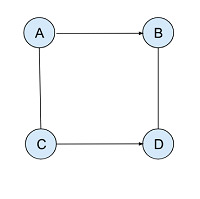C++ 统计邻居节点和最大为K的图中节点数量
介绍
无向图是计算机科学和图论的基本组成部分,表示由无方向性的边连接的一组顶点。与无向图相关的一个常见问题是计算图中邻居节点和最大为K的节点数量。在计算机科学中,图论领域将处理给定矩阵中元素之间的连接关系。通常,图由边和节点元素组成。
统计图中节点数量
在这种情况下,所使用的图是无向图。无向图包含“N”个节点,“M”条边,并且需要满足条件以获取最多为K的节点数量。下面是一个由四个节点组成的无向图的常见示例。

示例
以四个顶点的邻接矩阵作为输入。
1 2
2 3
3 4
4 5
邻居是指节点的左侧或右侧节点。在上述情况中,节点1返回邻居总和为1,节点2返回邻居总和为2,节点3返回邻居总和为3,节点4返回邻居总和为2,最后节点5返回邻居总和为1。当邻居总和小于或等于K时,我们需要检查节点总和。因此,满足条件的节点只有1个,它的值为1。
方法1:使用递归函数计算图中邻居总和最多为K的节点数的C语言代码
邻接矩阵被初始化为输入,并且可以使用深度优先搜索(DFS)或广度优先搜索(BFS)算法来遍历列表。
算法
- 第1步 - 所需的头文件是和,已包含在给定的程序中。
-
第2步 - 将函数定义为具有三个参数graph,N和K,数据类型为int。
-
第3步 - 计数变量初始化为0,并使用for循环从1到N迭代遍历图的相邻列表。
-
第4步 - 边连接两个点A和B,它是给定邻接列表中的相邻节点。
-
第5步 - 求和值存储在名为“sum”的变量中,它求和给定顶点中的权重或属性值。
-
第6步 - 检查条件,判断sum值是否小于或等于K,如果是,则将计数增加1。
-
第7步 - 最终输出包含图中邻居总和最多为K时节点数的计数。
示例
//The header files are included
#include <stdio.h>
#include <stdlib.h>
// Function defined with three arguments and declared as output
int output(int** graph, int node, int edges) {
//Initializing the variable as 0
int val = 0;
//for loop will iterate through the values
for (int m = 1; m <= node; ++m) {
int sum = 0;
for (int neighbor = 1; neighbor <= node; ++neighbor) {
sum += graph[m][neighbor];
}
//To check for the condition whether the sum value is less than or equal to edges
if (sum <= edges) {
//When equal it is incremented by one
val++;
}
}
return val;
}
// Main function to test the code
int main() {
//Initializing the variables with values
int node = 5, M = 4, edges = 2;
int** graph = (int**)malloc((node+1)*sizeof(int*)); // Indexed from 1 to N
for(int i=0; i<=node; ++i){
graph[i] = (int*)malloc((node+1)*sizeof(int));
for(int j=0; j<=node; ++j){
graph[i][j] = 0;
}
}
// The edges values are declared in the graph
graph[1][2] = 1;
graph[2][1] = 1;
graph[2][3] = 1;
graph[3][2] = 1;
graph[3][4] = 1;
graph[4][3] = 1;
graph[4][5] = 1;
graph[5][4] = 1;
//The function is called recursively with the parameters
int nodeCount = output(graph, node, edges);
printf("The total number of nodes with a sum of neighbors less than or equal to %d:\n%d\n", edges, nodeCount);
return 0;
}
输出
The total number of nodes with a sum of neighbors less than or equal to 2:
5
结论
使用C程序,构建代码 – 我们可以使用递归函数实现对给定无向图的计数。该函数与三个参数一起递归调用。通过使用pushback功能并添加用户给出的值的邻居元素,得到条件。
 极客笔记
极客笔记